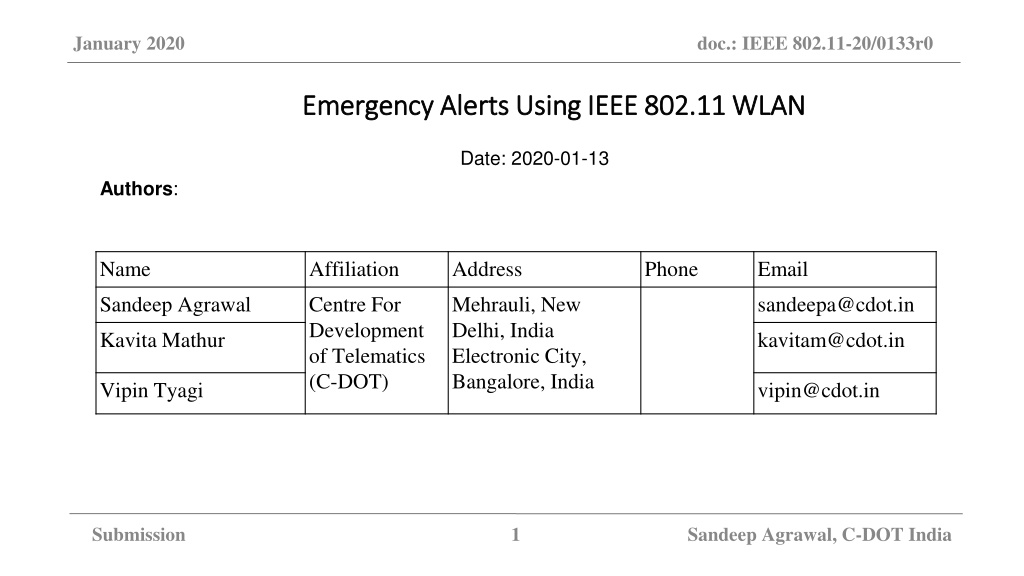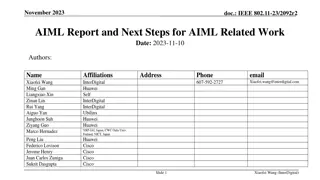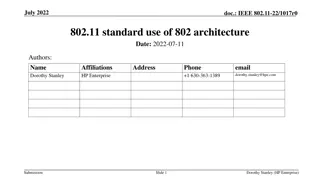Emergency Alerts Using IEEE 802.11 WLAN in India
Proposal for utilizing public Wi-Fi infrastructure in India for emergency communication, focusing on early alerts for natural and man-made disasters. Discusses the limitations of cellular communication and suggests using IEEE 802.11 WLAN technology to enhance communication in critical situations.
Download Presentation

Please find below an Image/Link to download the presentation.
The content on the website is provided AS IS for your information and personal use only. It may not be sold, licensed, or shared on other websites without obtaining consent from the author. Download presentation by click this link. If you encounter any issues during the download, it is possible that the publisher has removed the file from their server.
E N D
Presentation Transcript
January 2020 doc.: IEEE 802.11-20/0133r0 Emergency Alerts Using IEEE 802.11 WLAN Emergency Alerts Using IEEE 802.11 WLAN Date: 2020-01-13 Authors: Name Affiliation Address Phone Email Sandeep Agrawal Centre For Development of Telematics (C-DOT) Mehrauli, New Delhi, India Electronic City, Bangalore, India sandeepa@cdot.in Kavita Mathur kavitam@cdot.in Vipin Tyagi vipin@cdot.in Submission 1 Sandeep Agrawal, C-DOT India
January 2020 doc.: IEEE 802.11-20/0133r0 Outline Outline Introduction WLAN Deployment in India Scenario in India Support in Cellular Technology & Challenges IEEE 802.11 WLAN for Emergency Communication C-DOT Proprietary solution Use case Requirement IEEE 802.11 WLAN Capability Summary References Submission 2 Sandeep Agrawal, C-DOT India
January 2020 doc.: IEEE 802.11-20/0133r0 Introduction Introduction Early Emergency Alert to the citizens living in areas prone to natural disasters such as floods, earthquake, cyclones, man-made disasters such as terrorist attacks etc. Is a very critical requirement. In such situation, all available communication infrastructure in the area require to be efficiently used to enable critical communication. Today cellular, TETRA, P25, old analog system or satellite hand phones etc. are the main communication medium in such situations. ITU has defines CAP (Common Alert Protocol) to send emergency alert message in all disaster situations. Cellular based communication is limited to only SIM based devices. Other non-SIM based devices such as Laptops, Tablets and desktops used by citizen in such areas shall also be used in such situations. The Public Wi-Fi infrastructure is being deployed in every country. We propose to use this massive infrastructure for critical communication in emergency situation. Submission 3 Sandeep Agrawal, C-DOT India
January 2020 doc.: IEEE 802.11-20/0133r0 WLAN Deployment in India WLAN Deployment in India Submission 4 Sandeep Agrawal, C-DOT India
January 2020 doc.: IEEE 802.11-20/0133r0 Scenario in India Scenario in India Submission 5 Sandeep Agrawal, C-DOT India
January 2020 doc.: IEEE 802.11-20/0133r0 Emergency Alert in Cellular Technology Emergency Alert in Cellular Technology Cell Broadcast/Cell Information (CB) is a common method of sending messages to multiple mobiles telephone users in a defined area at the same time in all cellular networks. A Cell Broadcast Centre (CBC), a system which is the source of SMS-CB, is connected to a base station controller (BSC) in GSM networks, to a radio network controller (RNC) in UMTS networks, to a Mobility Management Entity (MME) in LTE networks or to a core Access and Mobility management Function (AMF) in 5G networks. A Cell Broadcast Entity (CBE) is a multi-user front-end that allows the definition and control of SMS-CB messages. A CBE can be located at the site of a content provider. At the site of the operator a so-called Cell Broadcast Centre (CBC) is located. The CBC is the heart of the Cell Broadcast System and acts as a server for all CBE clients. It takes care of the administration of all SMS-CB messages it receives from the CBEs and does the communication towards the GSM network. Submission 6 Sandeep Agrawal, C-DOT India
January 2020 doc.: IEEE 802.11-20/0133r0 Challenges with Cellular Network Challenges with Cellular Network Network Congestion Licensed Spectrum (costly) Very High CAPEX and OPEX Emergency messages can only be convey to SIM based devices Not easily deployable Coverage issue Rural: No Coverage Urban: Poor mobile coverage inside the buildings Mines, High rise building etc. Has coverage issue. Submission 7 Sandeep Agrawal, C-DOT India
January 2020 doc.: IEEE 802.11-20/0133r0 IEEE 802.11 WLAN for Emergency Communication IEEE 802.11 WLAN for Emergency Communication 802.11 WLAN is suitable network for Emergency Communication due to following features: Low cost network Low powered Hotspot (Can work on Solar powers) Unlicensed Spectrum A large number of users can be served with one Hotspot Backward compatible standards to support all user devices Easily deployable. (Deploying Wi-FI Hotspot with Satellite Backhaul is very easy compared to deploying Cellular) High Data Rate support SIM as well as Non SIM devices can get alerts Indoor coverage as well as outdoor Mesh topology for coverage extension in a given area Submission 8 Sandeep Agrawal, C-DOT India
January 2020 doc.: IEEE 802.11-20/0133r0 C C- -DOT Proprietary Solution DOT Proprietary Solution Submission 9 Sandeep Agrawal, C-DOT India
January 2020 doc.: IEEE 802.11-20/0133r0 How it works How it works When users are not connected to the 802.11 WLAN Access Point Configure multiple Virtual WLAN on the Access Point installed in the area Configure each Virtual WLAN SSID name with "Emergency Alert message" i.e. Rain is expected, Heavy Wind etc. When a user scan Wi-Fi Radio, he will see Emergency Alert message notification in the form of SSID name When users are connected to the 802.11 WLAN Access Point An application will be pre-installed on user device (in our case, the APP name is SAJAG (a Hindi word for ALERT)) The AP will send Emergency Alert message to the connected user device which will be received by the pre-installed application and display the message or enabling ringing etc. For notification. Submission 10 Sandeep Agrawal, C-DOT India
January 2020 doc.: IEEE 802.11-20/0133r0 Use case Use case To provide Emergency Alerts in: Remote and unconnected area with no cellular coverage Multi Dwelling and other buildings with intermittent or no cellular coverage Any indoor or outdoor locations (Urban, Semi Urban and Rural) with Wi-Fi coverage Submission 11 Sandeep Agrawal, C-DOT India
January 2020 doc.: IEEE 802.11-20/0133r0 Network Requirement Network Requirement Dedicated Channel: Dedicated Channel assigned for Emergency Alert messages Broadcast and multicast over Wireless: Communication medium to broadcast messages to all the clients (connected as well as not connected clients). Scalable and Easily Configurable: Network devices should be easily configurable and scalable. Provide Integrated Services: Voice, data and video information and integrating all communications from multimedia centre are required to enable fast and effective real-time decision making. Security: Security of messages are essential. Identification of valid source is mandatory Reliability: Reliability of an emergency network is important as emergency messages are exchanged in adverse environment. Dedicated resource allocation and priority routing for Emergency Message (preferable ITU defined CAP enabled messages) Communication and Response: The communication and response in an emergency network would be real-time and having low latency is crucial. Spectrum Sharing: Need optimal way to share spectrum since resources available during disaster would be limited. Dispatch and Control: In a classical emergency communication system, messages are routed through hierarchical dispatch and control structure. Robust and Resilient: Rescue operations take place under unfavourable conditions and the in order to cope, the networks deployed should be robust and resilient. QoS: An emergency network has to conform to a strict Quality of Service (QoS) to ensure optimised performance with limited resources. Backward compatibility: to support all generation of mobiles with Wi-Fi support Submission 12 Sandeep Agrawal, C-DOT India
January 2020 doc.: IEEE 802.11-20/0133r0 Summary Summary We propose to IEEE 802.11 WNG to start a Technical Study to find gaps in existing WLAN standard to support reliable communication for Emergency alerts during disaster situation Submission 13 Sandeep Agrawal, C-DOT India
January 2020 doc.: IEEE 802.11-20/0133r0 References References l https://www.itu.int/en/ITU-D/Emergency-Telecommunications/Pages/default.aspx l www.cellbroadcastforum.org l https://www.cse.wustl.edu/~jain/cse574-14/ftp/disaster/index.html l https://standards.ieee.org/standard/802_11-2016.html l http://www.ieee802.org/11/Reports/tgbc_update.htm l https://www.sharetechnote.com/html/Handbook_LTE_ETWS.html l http://dot.gov.in/sites/default/files/Final%20NDCP-2018_0.pdf Submission 14 Sandeep Agrawal, C-DOT India























